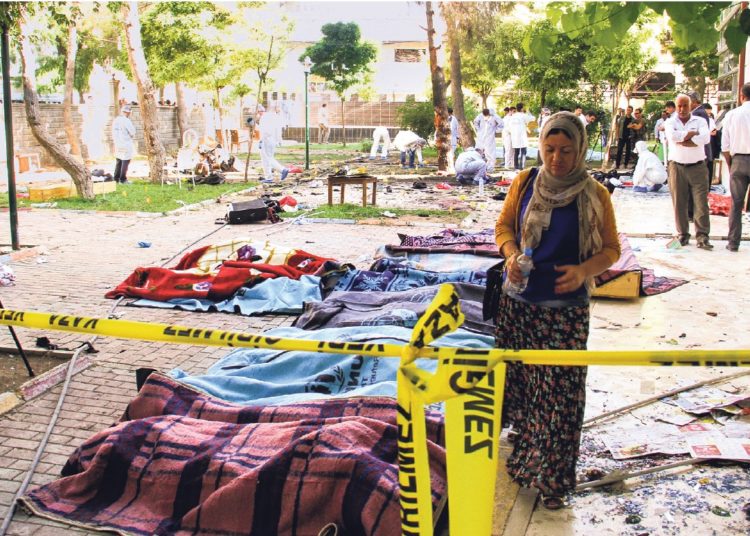Abdullah Bozkurt/Stockholm
Contrary to a recommendation in an internal investigation report, the government of President Recep Tayyip Erdoğan did not allow the prosecution of border town district governor Abdullah Çiftçi, who failed to take measures to prevent one of the deadliest terrorist attacks in Turkey perpetrated by an Islamic State in Iraq and Syria (ISIS) suicide bomber.
The confidential investigation report, drafted by Interior Ministry inspectors and obtained by Nordic Monitor, recommended the prosecution of the district governor of the border town of Suruç in southeastern Şanlıurfa province. The inspectors discovered that the governor was aware of intelligence about a possible ISIS suicide bombing in the town, yet did not order security measures ahead of a large gathering of activists who wanted to protest ISIS attacks in Syria.
The governor, police chief and other town officials were in a heightened state of alert over an upcoming visit by a group of activists, mostly from the Federation of Socialist Youth Associations (SGDF) as well as Kurdish socialists, who planned to contribute to efforts to rebuild the Syrian border town of Kobani, largely destroyed in a battle in which ISIS was pushed out.
They knew the group would be a primary target by ISIS and had the intelligence that the terrorist group might launch an attack in the town including a suicide bombing. But the governor did not order measures in or around the Amasra Cultural Center, the venue where the activists gathered and made a statement to the press, facilitating the entry of an ISIS suicide bomber into the area.
Confidential internal investigation report about ISIS suicide bombing in 2015:
As a result, on July 20, 2015 ISIS suicide bomber Şeyh Abdurrahman Alagöz, who turned out to already be on a watch list, had no trouble in accessing the venue and perpetrating the attack that killed 33 people and injured 59.
After the attack, the district governor’s actions were subject to an internal inquiry by Ministry of Interior inspectors, who concluded that the governor did not do his job as required by law and recommended that he be investigated by the judicial authorities. However, the prosecution of an official requires advance permission from the government, and President Erdoğan’s administration refused to grant permission so that he could be held accountable in a court of law.
Instead, Çiftçi served as the governor of Suruç until 2016 and was later appointed as district governor of Çınarcık, a district of Yalova province near Istanbul, where he served two years. In 2018 Erdoğan sent him to Sur in the predominantly Kurdish southeastern province of Diyarbakır as district governor. He also held the position of deputy mayor of the district after the government removed the elected Kurdish mayor. In August of this year, he was promoted to serve as deputy governor of Diyarbakır.
The inspection report, dated October 12, 2015 and signed by four investigators, also revealed that the police department in the neighboring province of Adıyaman, where the suicide bomber maintained a residence, informed the Security Directorate General (Emniyet) on October 13, 2014 that the bomber had travelled to Syria. However that intelligence was not shared by the Emniyet in Ankara with other intelligence branches.

The governor and police chief in the town ordered the establishment of checkpoints for visitors a day before the bombing and on the day the attack took place, mainly targeting SGDF group members as potential troublemakers rather than focusing on an ISIS threat. Two members of the group, Emrah Ilingi and Servet Toygar, were detained by police at a checkpoint since they were the subjects of outstanding arrest warrants. The group was monitored closely by undercover intelligence units while they were in the city.
However, the police did not set up a security checkpoint at the only entry to the culture center despite the fact that they had a sweeping warrant from a judge who on July 7 authorized the police to search anybody for a month, until August 8, as part of preventive measures against security threats. The warrant specifically mentioned “11 Nisan,” the street where the venue was located.
Inspectors noted in their report that the police could have deployed a unit and set up a secure point at the gate for people entering the venue based on the judge’s warrant and possibly could have caught the suicide bomber before he blew himself up.

Moreover, an order issued by Şanlıurfa Governor Izzettin Kucuk on July 17 listed the security measures the police in the district were required to take ahead of the SGDF group’s visit to the town and specifically mentioned a suicide bombing attack, asking all police units to be vigilant about such a possibility.
Yet, nether the district governor nor police chief Mehmet Yapalıal ordered the establishment of a secure checkpoint in or around the culture center to catch the suicide bomber. As a result, the inspectors recommended that the government grant permission to prosecute both of them.
The Erdoğan government only gave permission for the police chief, denying the request for the district governor. Even the prosecution of the police chief turned out to be merely symbolic. He was indicted, and the trial resulted in a conviction and eight-month sentence. But the judges converted the sentence into a fine of 7,500 Turkish lira (approximately $133), payable in 12 monthly installments, allowing him to walk free.
Yapalıal’s career in the police department was not the least bit impacted by this. In what was seen as a reward for his service, President Erdoğan appointed him to be a district police chief in the popular tourist destination of Fethiye, a town in the western province of Muğla.












